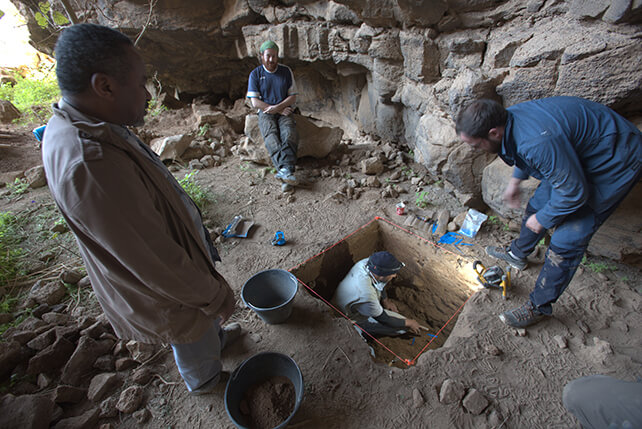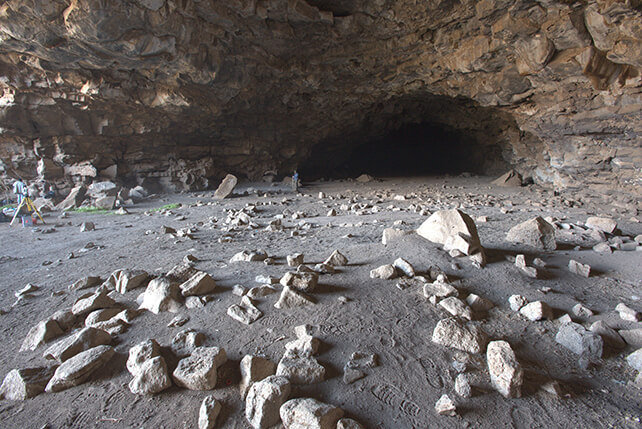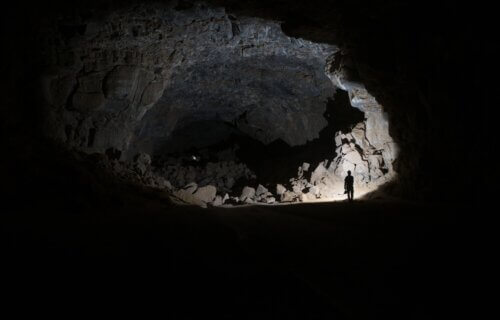HARRAT KHAYBAR, Saudi Arabia — Scientists appear to have uncovered a hidden chapter of human history — inside a massive lava tube in Saudi Arabia. It’s the first evidence that ancient humans occupied these giant caves formed by volcanic activity in the Middle East, giving modern-day scientists a glimpse into the lives of early desert dwellers.
Lava tubes, naturally formed underground tunnels left by flowing lava, have not been extensively explored archaeologically in Saudi Arabia until now. These caves can extend for substantial distances and often feature skylights where portions of the roof have collapsed. It is within one of these collapsed sections that the team made their remarkable find. Umm Jirsan, a lava tube stretching over 1.5 kilometers within the ancient lava fields of Harrat Khaybar, has proven to be a treasure trove of historical significance.
The findings shed new light on the lives of pastoral populations in the Arabian Peninsula spanning from the Neolithic period to the Chalcolithic/Bronze Age, a timeframe ranging from roughly 10,000 to 3,000 years before present.
The research, spearheaded by Matthew Stewart and his colleagues from the Max Planck Institutes and several global universities, shows that Umm Jirsan served as a seasonal refuge for pastoral communities. According to the findings published in PLOS ONE, these early inhabitants left behind a wealth of artifacts, including stone tools, animal bones, and even ancient rock art, which tell stories of survival and adaptation in an unforgiving climate.
“This site likely served as a crucial waypoint along pastoral routes, linking key oases and facilitating cultural exchange and trade,” says Dr. Stewart in a media release.

What makes Umm Jirsan particularly fascinating is its continuous use through various prehistoric periods. From at least the Neolithic through the Bronze Age, people returned to this lava tube, drawn by its protective embrace and perhaps its spiritual significance. The cave’s internal environment, naturally regulated, offered protection from the scorching heat and preserved organic materials that are rarely found in the arid surface conditions typical of the region.
While previous research in the area had primarily focused on open-air sites, the protected environment of the lava tube offered a unique opportunity for preservation. The researchers meticulously excavated a small trench, revealing a series of occupation layers dating back thousands of years. They discovered lithic (stone tool) assemblages that include tools made from obsidian — a volcanic glass — suggesting long-distance trade or travel. The presence of obsidian points to a network of exchange and interaction across ancient Arabia, connecting Umm Jirsan’s inhabitants with distant communities.
The oldest layer, estimated to be between 10,300 and 8,700 years old, contained a treasure trove of information about the early inhabitants of the region. The team uncovered numerous animal bones, including those of wild and domestic species such as gazelles, goats, and cattle. The presence of both types of animals suggests that the people using the lava tube were skilled hunters and herders, likely moving seasonally with their livestock between pastures.
Intriguingly, the researchers also discovered bones showing signs of butchery and burning, indicating that the cave served as a place for food preparation and consumption. These findings paint a picture of the lava tube as a temporary shelter for ancient pastoralists, offering respite from the harsh desert conditions.
As the team explored the upper layers of the excavation, they found evidence of more recent occupations. Radiocarbon dating revealed that a human cranium discovered in a nearby part of the lava tube was approximately 6,800 years old, placing it within the Neolithic period. This individual’s presence coincides with the construction and use of enigmatic stone structures called “mustatils” in the surrounding region, which are believed to have served ritualistic purposes.
The researchers also uncovered a wealth of rock art in a nearby lava tube. These engravings, estimated to be from the Chalcolithic period (roughly 5,000 to 3,000 years before present), depicted scenes of livestock herding and hunting. The dominance of sheep and goat in these illustrations sets them apart from rock art found in other parts of Arabia, which tend to feature cattle more prominently. This unique insight into the cultural significance of certain animals hints at the adaptability of ancient peoples to their local environment.

To gain a deeper understanding of the diet and lifestyle of the lava tube’s inhabitants, the researchers conducted isotopic analyses on the human and animal remains. The results showed that the humans had a protein-rich diet, with animal products constituting a significant portion of their food intake. However, over time, there was an increase in the consumption of plant foods, possibly linked to the emergence of oasis agriculture during the Bronze Age.
The animal remains told a slightly different story. The strong correlation between carbon and nitrogen isotope ratios suggested that the livestock were primarily grazing on wild grasses rather than being foddered by humans. This discovery paints a picture of ancient herders moving with their animals across the landscape, following the seasonal availability of resources.
“While underground localities are globally significant in archaeology and Quaternary science, our research represents the first comprehensive study of its kind in Saudi Arabia,” adds Professor Michael Petraglia, Director of Griffith University’s Australian Research Centre for Human Evolution (ARCHE). “These findings underscore the immense potential for interdisciplinary investigations in caves and lava tubes, offering a unique window into Arabia’s ancient past.”
The Umm Jirsan lava tube is a testament to the ingenuity and resilience of ancient peoples in the face of challenging environments. The findings from this study provide a rare glimpse into the daily lives and cultural practices of Arabia’s early pastoralists. By seeking shelter in the lava tube, these intrepid individuals were able to thrive in an arid landscape, leaving behind clues for modern archaeologists to uncover.
As research continues at this fascinating site, it is clear that lava tubes like Umm Jirsan hold immense potential for expanding our understanding of human prehistory in the region. The unique preservation conditions within these subterranean spaces offer a window into the past that open-air sites simply cannot provide.
Article reviewed by StudyFinds Editor Chris Melore.

“a glimpse into the lives of early desert dwellers.”
Beginning 10,500 years ago, and lasting for about 5,000 years, this area was a savannah due to monsoon rains that dominated the period. I wonder if these remnants were due to human migrations.
I was thinking that. I know here in North America, for example, the entire mid-America was a vast ocean for countless (to me) aeons. If there is a desert in Arabia now it may not have always been a desert. But I’m beyond being just an amateur, so I’m just wondering.
How old is the lava tube itself?